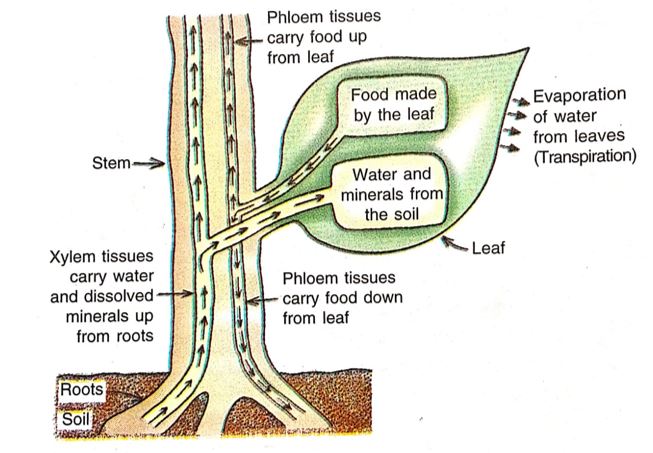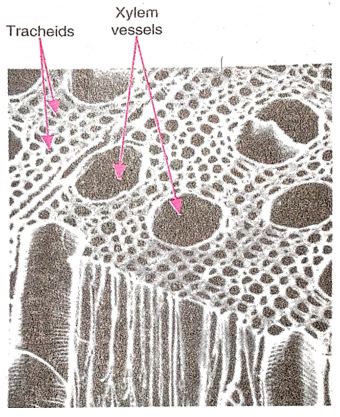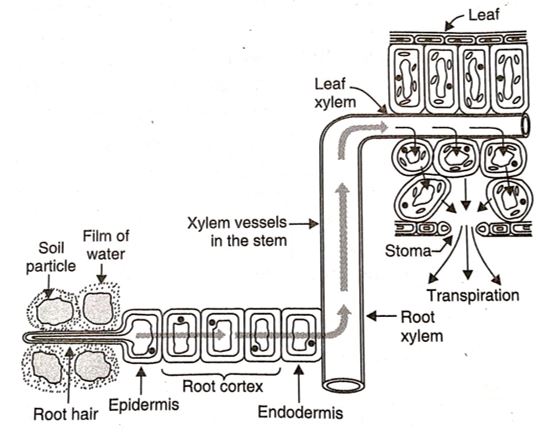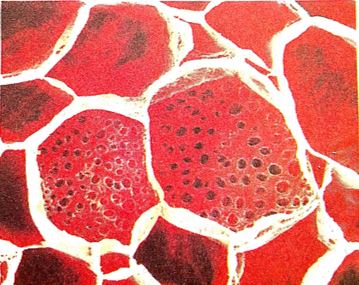The body of every organism (plant or animal) is made up of cells. A large organism-has millions and .millions of cells in its body. In order that the organism may be able to maintain its life and survive, all its cells must be supplied with essential substances like food, oxygen, water, etc. So, some arrangement is required inside an organism which can carry the essential substances to all its parts so that they reach each and every cell of its body.
In everyday language, ‘transport’ means ‘to carry things from one place to another’. In biology, transport is a life process in which a substance absorbed (or made) in one part of the body of an organism is carried to other parts of its body. Large organisms (large plants and animals) need transport systems in their bodies to supply all their cells with food, oxygen, water, and other materials. In fact, special tissues and organs are needed for the transport of substances in plants and animals organs can pick up the essential substances like food, oxygen, water, etc., at one end of their body and carry them to all other parts.
We will now study the transport system of plants and of human beings, and describe the parts which make up these systems. In other words, we will learn how plants and animals carry substances from one part of their body to another.
Transport in Plants
Contents
Transport system in plants is less elaborate than in animals (including human beings). Plants are less active, so their cells do not need to be supplied with materials so quickly. Also, due to the branching shape of a plant, all the cells of a plant can get oxygen for respiration and carbon dioxide for photosynthesis directly from the air by diffusion. So, the only substances which are to be supplied to a plant through a transport system are water and minerals (which they can’t get from the air). Another job of the transport system of plants is to transport food prepared in the leaves to the various parts of the plant like stems, roots, etc. The plants have two types of conducting tissues called xylem and phloem. Xylem tissues carry water and minerals whereas phloem tissues carry the food prepared by the plants. We can now say that:
Diagram to show the transport system in plants.
The plants have two transport systems:
1. Xylem which carries water and minerals, and
2. Phloem which carries the food materials which the plant makes (Phloem also carries the hormones made by the plants in their root and shoot tips).
The transport of materials in a plant can be divided into two parts:
(i) Transport of water and minerals in the plant, and
(ii) Transport of food and other substances (like hormones) in the plant.
We will now discuss both the parts of the transport system in plants in detail, one by one. Let us start with the transport of water and minerals in the plants.
Transport of Water and Minerals
Plants require water for making food by photosynthesis. Plants also need mineral salts for various purposes (such as making proteins, etc.). Water and minerals are absorbed from the soil by the roots of the plant and transported to the various parts of the plant like stem, leaves and flowers. In the leaves, water is used in making food by photosynthesis. The water and minerals dissolved in it move from the roots of the plant to its leaves through the two kinds of elements of the xylem tissue called xylem vessels and tracheids. Xylem vessels and tracheids are both non-living conducting tissues which have thick walls. Let us discuss xylem vessels and tracheids in a little more detail.
1. Xylem Vessels
The xylem vessel is a non-living, long tube which runs like a drainpipe through the plant. A xylem vessel is made of many hollow, dead cells (called vessel elements), joined end to end. The end walls of the cells have broken down so a long; open tube is formed. Xylem vessels run from the roots of the plant right up through the stem and reach the leaves. The xylem vessels branch into every leaf of the plant.
Xylem vessels do not contain the cytoplasm or nuclei. The walls of xylem vessels are made of cellulose and lignin. Lignin is a very hard and strong substance, so xylem vessels also provide strength to the stems and help to keep the plant upright. Wood is made almost entirely of lignified xylem vessels. Xylem vessels have pits in their thick cell walls. Pits are not open pores. Pits are the thin areas of the cell wall where no lignin has been deposited. Pits have unthickened cellulose cell wall.
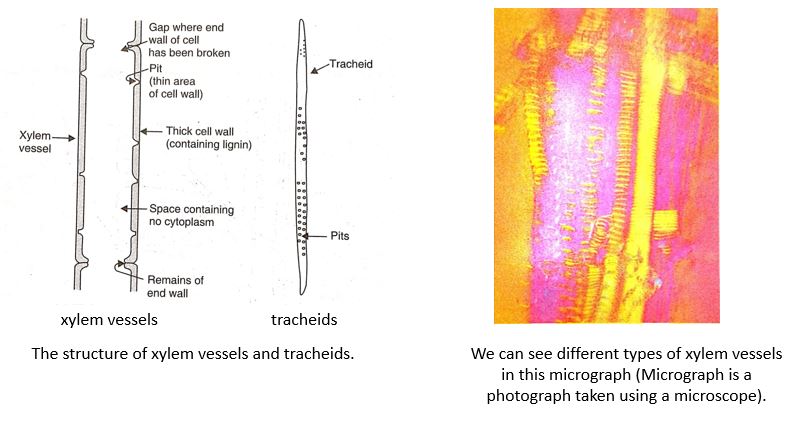
In flowering plants, either only xylem vessels transport water or both xylem vessels and tracheids transport water.
2. Tracheids
Tracheids are long, thin, spindle shaped cells with pits in their thick cell walls. Water flows from one tracheid to another through pits. Tracheids are dead cells with lignified walls but they do not have open ends, so they do not form vessels. They are elongated cells with tapering ends. Even though their ends are not completely open, tracheids have pits in their walls, so water can pass from one tracheid to another through these pits. Although all the plants have tracheids, they are the only water conducting tissue in non-flowering plants.
Before we describe the mechanism of the transport of water from the roots of a plant to the leaves, we should know the meanings of the terms epidermis, endodermis, root cortex and root xylem. The outer layer of cells in the root is called epidermis. Epidermis is only one cell thick. The layer of cells around the vascular tissues (xylem and phloem) in the root is called endodermis (It is the innermost layer of cortex). The part of root between the epidermis and endodermis is called root cortex. And the xylem tissue present in roots is called root xylem. Please note that in a root, the root hair are at its outer edge but the root xylem vessels (which carry water to the other parts of plant) are at the centre of the root. And in-between the root hair and root xylem are epidermis, root cortex and endodermis. So, before water absorbed by root hair from the soil reaches the root xylem, it has to pass through the epidermis, root cortex and endodermis.
This is the scanning electron micrograph of the xylem tissues in the stem of a plant. We can see the xylem vessels and tracheids which taken together form the xylem tissue (Scanning electron micrograph is a highly magnified photograph taken by scanning electron microscope which uses an electron beam instead of light to produce highly magnified images).
Another point to be noted is that the minerals needed by the plants are taken up by the plants in inorganic form such as nitrates and phosphates. These minerals are present in the soil. The minerals present in soil dissolve in water to form an aqueous solution. So, when water is transported by the root of the plant to its leaves, then the minerals dissolved in it also get transported along with it.
Mechanism of Transport of Water and Minerals in a Plant
The plants take in water (containing dissolved minerals) from the soil through their roots. This water (containing minerals) called xylem sap is carried by the xylem vessels to all the parts of the plant. This happens as follows: The roots of a plant have hair called root hairs. The function of root hairs is to absorb water and minerals from the soil. The root hairs are directly in contact with the film of water in-between the soil particles. Water (and dissolved minerals) get into the root hairs by the process of diffusion. The water and minerals absorbed by the root hair from the soil pass from cell to cell by osmosis through the epidermis, root cortex, endodermis and reach the root xylem.
Diagram to show how water and dissolved minerals) are transported from the soil up to the leaf of a plant.
The xylem vessels of the root of the plant are connected to the xylem vessels of its stem. So, the water (containing dissolved minerals) enters from the root xylem vessels into stem xylem vessels. The xylem vessels of the stem branch into the leaves of the plants. So, the water and minerals carried by the xylem vessels in the stem reach the leaves through the branched xylem vessels which enter from the petiole (stalk of the leaf) into each and every part of the leaf. In this way, the water and minerals from the soil reach through the root and stem to the leaves of the plant. Only about 1 to 2 per cent of the water absorbed by the plant is used up by the plant in photosynthesis and other metabolic activities. The rest of water is lost as water vapour to the air through transpiration.
Water is Sucked Up by the Xylem Vessels
Water moves up into xylem vessels in the same way that a cold drink moves up a straw when we suck at the upper end of the straw. Now, when we suck a straw, we are reducing the pressure at the top of the straw. The cold drink at the bottom of the straw is at a higher pressure (which is atmospheric pressure), so the cold drink flows up the straw into our mouth. The same thing happens with the water in the xylem vessels. The pressure at the top of the xylem vessels (in the leaves) is lowered whereas the pressure at the bottom of the xylem vessels remains high. Due to this water flows up the xylem vessels into the leaves. An important question now arises : How is the pressure at the top of the xylem vessels reduced ? The pressure at the top of xylem vessels in a plant is reduced due to transpiration. This is discussed below :
The evaporation of water from the leaves of a plant is called transpiration. The leaves of a plant have tiny pores on their surface which are called stomata. A lot of water from the leaves keeps on evaporating to the air through the stomata. This loss of water (as water vapour) from the leaves of a plant is called transpiration. Since the cells of the leaf are losing water by transpiration, so water from the xylem vessels in the leaf will travel to the cells by osmosis to make up this loss of water. Thus, water is constantly being taken away from the top of the xylem vessels in the leaves to supply it to the cells in the leaves. This reduces the effective pressure at the top of the xylem vessels, so that water flows up into them (from the soil). Thus, the continuous evaporation of water (or transpiration) from the cells of a leaf creates a kind of suction which pulls up water through the xylem vessels. In this way,
up water through the xylem vessels. In this way, the process of transpiration helps in the upward movement of water and dissolved minerals) from the roots to the leaves through the stem.
Transport of Food and Other Substances
Leaves make food by the process of photosynthesis. The food made by leaves is in the form of simple sugar (glucose). Other types of substances called plant hormones are made in the tips of roots and shoots. Now, every part of the plant needs food. So, food made in the leaves of a plant has to be transported (or carried) to all the parts of the plant like branches, stem and roots, etc. The food manufactured by the leaves of a plant is transported to its all other parts through a kind of tubes called phloem (which are present in all the parts of a plant). The transport of food from the leaves to other parts of the plant is called translocation. Thus, phloem translocates the food (or sugar) made in the leaves. The movement of food materials (and other substances like hormones) through phloem depends on the action of living cells called sieve tubes.
Phloem Contains Sieve Tubes
Like xylem vessels, phloem is made of many cells joined end to end to form long tubes. However, the end walls of the cells which form phloem are not completely broken down.
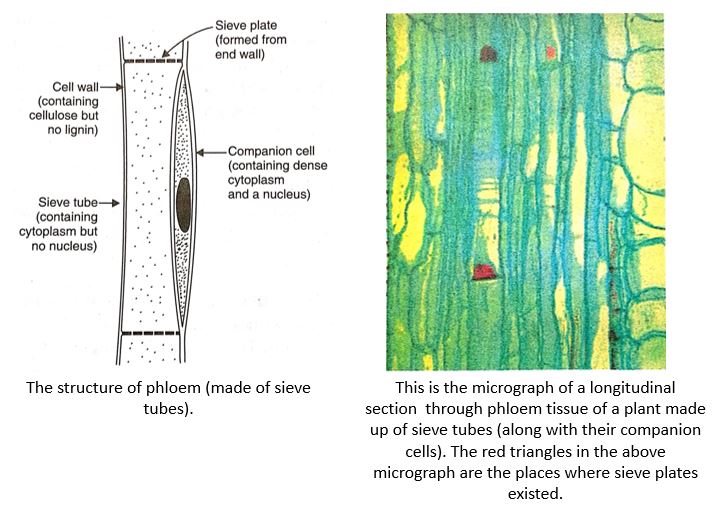 The end walls of cells in the phloem form sieve plates, which have small holes in them. These holes in the sieve plates allow the food to pass along the phloem tubes. The cells of phloem are called sieve tubes (or sieve elements). Sieve tubes which form phloem are living cells which contain cytoplasm but no nucleus. The sieve tube cells do not have lignin in their walls. Each sieve tube cell has a companion cell next to it. The companion cell has a nucleus and many other organelles. Companion cells supply the sieve tubes with some of their requirements.
The end walls of cells in the phloem form sieve plates, which have small holes in them. These holes in the sieve plates allow the food to pass along the phloem tubes. The cells of phloem are called sieve tubes (or sieve elements). Sieve tubes which form phloem are living cells which contain cytoplasm but no nucleus. The sieve tube cells do not have lignin in their walls. Each sieve tube cell has a companion cell next to it. The companion cell has a nucleus and many other organelles. Companion cells supply the sieve tubes with some of their requirements.
The food is made in the mesophyll cells (or photosynthetic cells) of a leaf. The food (like sugar) made by the mesophyll cells of a leaf enters into the sieve tubes of the phloem. Interconnected phloem tubes are present in all the parts of the plant. So, once the food (like sugar) enters the phloem tubes in the leaves, it is transported (or carried) to all other parts of the plant by the network of phloem tubes present in all the parts of the plant like steam and roots.
We can see the sieve plates and sieve tubes clearly in this transverse section of phloem.
The translocation (transport of food from leaves to other parts of the plant) is necessary because every part of the plant needs food for obtaining energy, for building its parts and maintaining its life. Please note that when food is transported in a plant through a network of phloem tubes, then other substances made by the plant (like hormones) are also carried by the phloem tubes from one part of the plant to its other parts.
We have already studied that the movement of water (and dissolved salts) in xylem is always upwards (from soil to leaves) and it is caused by the suction of water at the top because of low pressure created by transpiration from leaves. The movement of food in phloem can be, however, upwards or downwards depending on the needs of the plant. We will now describe how food moves in the phloem tissue of a plant.
Mechanism of Transport of Food in a Plant
The movement of food in phloem (or translocation) takes place by utilising energy. This happens as follows: The sugar (food) made in leaves is loaded into the sieve tubes of phloem tissue by using energy from ATP. Water now enters into sieve tubes containing sugar by the process of osmosis due to which the pressure in the phloem tissue rises. This high pressure produced in the phloem tissue moves the food to all the parts of the plant having less pressure in their tissues. This allows the phloem to transport food according to the needs of the plant. For example, in spring, even the sugar stored in the root or stem tissue of a plant would be transported through phloem to the buds which need energy to grow.
Let us answer one question now.
Question: The xylem in plants are responsible for :
(a) transport of water
(b) transport of food
(c) transport of amino acids
(d) transport of oxygen
Answer: (a) transport of water.
You can write your questions and suggestions to us in the comment box given below.
Thank you

